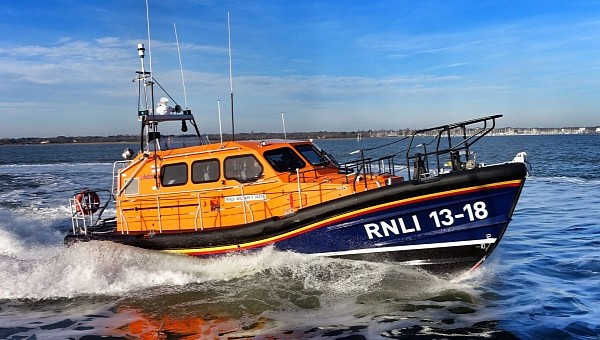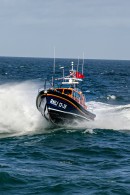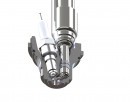Electrification is happening across the globe – although we can see it most in the automotive world, other segments are also experiencing this switch. For instance, the maritime industry is finding ways to reduce carbon emissions for many types of vessels. Many older vessels out there make up a large portion of carbon emissions, and some can be fitted with batteries or other electrified technologies. But what happens to those that aren't compatible? Well, one solution comes from Mahle.
The Mahle Group covers a multitude of initiatives – it's committed to making transportation more efficient, comfortable, and environmentally friendly. It does so by optimizing combustion engines, using alternative fuels, and coming up with applications for electrified solutions. Mahle Powertrain is the Engineering Services subsidiary of the larger group, but it operates independently – it's a development partner in e-mobility, thermal management, and powertrain technology.
The company is leading a consortium in the UK with partners, including the Royal National Lifeboat Institution (RNLI), to create a sustainable propulsion solution that can be retrofitted to high-performance marine vessels. Other collaborators are the University of Nottingham and Clean Air Power, and together, the organizations will initially target search and rescue vessels.
Current battery technologies aren't the perfect solution for maritime vessels – they have a low energy density and a significant weight, and charging typically takes a long time. To solve these issues, Mahle optimized its Jet Ignition technology for hydrogen combustion under the name HyJet.
According to Victoria Limbrick, RNLI's Carbon and Energy manager, lifeboats, rescue watercraft, and logistics vehicles account for about 57% of the total RNLI energy use. HyJet is an excellent opportunity to explore potential solutions to meet sustainability targets.
Before I tell you more about HyJet, let me explain how Mahle's Jet Ignition works. The technology comprises a small pre-chamber that can be fitted into the cylinder head. Combustion is started in this pre-chamber, and the resulting hot gas is forced through small orifices into the main combustion chambers. Furthermore, a series of jets rapidly and uniformly ignite the remaining mixture. This is how efficient and clean combustion is ensured, and little to no pollutants, such as nitrogen oxides, are emitted.
The first step in the HyJet project is to analyze usage data from the RNLI's vessels during real-world operations to recognize the fleet requirements in order to establish the optimum approach for a clean operation. Other critical details that must be considered are onboard fuel storage and refueling, as well as the technology's impact on vessel safety standards and regulatory compliance. The project is meant to be scaled across professional, commercial, and governmental fleets.
HyJet's findings will serve as the basis for a follow-on project to produce a real-world demonstrator vessel. By focusing on commercialization, the initiative will create a scalable route to market so the marine industry can benefit from reduced greenhouse gas emissions.
The company is leading a consortium in the UK with partners, including the Royal National Lifeboat Institution (RNLI), to create a sustainable propulsion solution that can be retrofitted to high-performance marine vessels. Other collaborators are the University of Nottingham and Clean Air Power, and together, the organizations will initially target search and rescue vessels.
Current battery technologies aren't the perfect solution for maritime vessels – they have a low energy density and a significant weight, and charging typically takes a long time. To solve these issues, Mahle optimized its Jet Ignition technology for hydrogen combustion under the name HyJet.
According to Victoria Limbrick, RNLI's Carbon and Energy manager, lifeboats, rescue watercraft, and logistics vehicles account for about 57% of the total RNLI energy use. HyJet is an excellent opportunity to explore potential solutions to meet sustainability targets.
Before I tell you more about HyJet, let me explain how Mahle's Jet Ignition works. The technology comprises a small pre-chamber that can be fitted into the cylinder head. Combustion is started in this pre-chamber, and the resulting hot gas is forced through small orifices into the main combustion chambers. Furthermore, a series of jets rapidly and uniformly ignite the remaining mixture. This is how efficient and clean combustion is ensured, and little to no pollutants, such as nitrogen oxides, are emitted.
The first step in the HyJet project is to analyze usage data from the RNLI's vessels during real-world operations to recognize the fleet requirements in order to establish the optimum approach for a clean operation. Other critical details that must be considered are onboard fuel storage and refueling, as well as the technology's impact on vessel safety standards and regulatory compliance. The project is meant to be scaled across professional, commercial, and governmental fleets.
HyJet's findings will serve as the basis for a follow-on project to produce a real-world demonstrator vessel. By focusing on commercialization, the initiative will create a scalable route to market so the marine industry can benefit from reduced greenhouse gas emissions.






